Mitosis vs Meiosis
Difference Between Mitosis and Meiosis
 Mitosis refers to duplication of a non sex cell into two diploid cells (diploid means that it has two sets of chromosomes - one from mom and one from dad) and Meiosis refers to the duplication of sex cells only; sperm and egg. Meiosis of one sex cell results in 4 haploid cells (haploid means that it only has one set of chromosomes to be contributed to another set during fertilization when we receive one set of chromosomes from mom and one set from dad). Mitosis is the duplication of new cells in eukaryotes; cells that have membrane bound organelles (organelles are the organs of a cell such as the mitochondria). The typical cell spends most of its time in a stage where it is performing its normal cellular functions, but because cells wear out, they need to be replaced. Mitosis strictly refers to the duplication of the DNA inside the nucleus. The term Mitotic phase refers to the entire cell division process.
Mitosis refers to duplication of a non sex cell into two diploid cells (diploid means that it has two sets of chromosomes - one from mom and one from dad) and Meiosis refers to the duplication of sex cells only; sperm and egg. Meiosis of one sex cell results in 4 haploid cells (haploid means that it only has one set of chromosomes to be contributed to another set during fertilization when we receive one set of chromosomes from mom and one set from dad). Mitosis is the duplication of new cells in eukaryotes; cells that have membrane bound organelles (organelles are the organs of a cell such as the mitochondria). The typical cell spends most of its time in a stage where it is performing its normal cellular functions, but because cells wear out, they need to be replaced. Mitosis strictly refers to the duplication of the DNA inside the nucleus. The term Mitotic phase refers to the entire cell division process.
It is important to remember that most cells spend their time performing normal metabolic functions and are not in a state of constant division. This phase is known as the G Zero phase. Some cells in the human body are permanently in this phase; cells that never divide, like neurons for example.
Interphase is the phase of growing bigger and duplicating the DNA and organelles.
Cell division happens like this: First, there is the Gap 1 phase where the cell starts to grow bigger by creating more cytoplasm and more organelles in preparation for division. Next is the Synthesis phase where the cell replicates its DNA within the nucleus, then comes Gap 2 where the cell continues to grow larger and create new organelles.
Prophase is where the loosely bound DNA condenses into chromosomes. Most of the time, your DNA is sitting unbound in the nucleus; stretching its coils as it were. In prophase, the two chromosomes join together to become sister chromatids. When I say two chromosomes here, there are actually four individual chromosomes because remember that each cell already has two sets; one from each parent, so in the Synthesis stage, both sets are duplicating resulting in four chromosomes.
In Metaphase, the sister chromatids line up at the point where the nucleus will split in half.
In Anaphase, the sister chromatids are split up into sister chromosomes, each ready to be inside a new nucleus.
In Telophase, the sister chromosomes are becoming bound into a new nuclear envelope, each ready to become the nucleus of its own cell. While Telophase is happening, Cytokinesis is taking place; the process of the whole cell dividing. Clefts appear on the surface of the cell and deepen. This will be the pinching off point between the two new cells.
The same stages happen in Meiosis, with a few differences. During the Synthesis phase, two sets of chromosomes become four; like before, but the arms of these chromosomes will cross with each other and recombine their DNA, so each chromosome has a different mixture of genes from mom and dad. That is why, with the exception of identical twins, no child of the same parents will look the same as the other as there are millions of possible combinations. In addition, Meiosis goes through this cycle twice instead of just once; Meiosis 1 and Meiosis 2.
In Prophase, the DNA duplicates as before, but the chromosomes recombine, creating genetic variability. This is unique to Meiosis.
In Metaphase, the cells line up as before.
In Anaphase, whole chromosomes are pulled to the opposite side of the nucleus in preparation for division.
In Telophase, each cell receives 46 chromosomes, but they aren’t in homologous pairs. Each person has 46 chromosomes in the nucleus of their cells, but they are in homologous pairs, meaning that the same genes are in the same places, but the actual genetic information is different. A new nuclear envelope forms around these two sets of haploid cells and cytokinesis begins which splits the cell in half.
In Meiosis 2, all of the same phases occur as before, but each of the two cells created in Meiosis 1 divide resulting in 4 cells, each with 23 chromosomes.
To summarize Mitosis vs Meiosis; Mitosis is the division of non sex cells to create two identical daughter cells with a complete set of chromosomes from both parents; 23 pairs. Meiosis is the division of sex cells to create 4 different daughter cells, each with 23 individual chromosomes.
Differences between mitosis and meiosis
| MITOSIS | MEIOSIS | ||
|---|---|---|---|
| In somatic cells | In reproductive cells | ||
| One single division (here below A-E) of the mother cell (m) results in two daughter cells (d) | 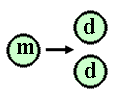 | Two divisions (here below: meiosis I in A-E and meiosis II in F-H) of the mother cell (meiocyte; m) result in four meiotic products (p) | 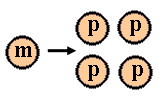 |
 | 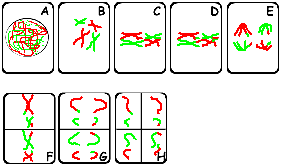 | ||
| A mitotic mother cell can be either haploid or diploid | 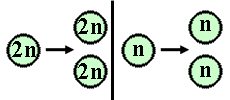 | A meiotic mother cell (meiocyte) is always diploid | 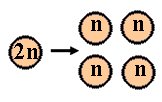 |
| The number of chromosomes per nucleus remains the same after division | Diploid (= 2n) remains 2n Haploid (= 1n) remains 1 n | The meiotic products contain a haploid (n) number of chromosomes, in contrast to the 2 n mother cell | From 2n to n |
| Mitosis is preceeded by a S-phase in which the amount of DNA is duplicated | Example for a diploid mother cell: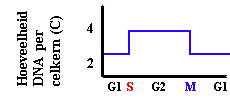 | Only meiosis I is preceeded by a S-phase | 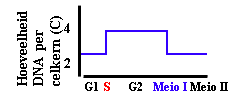 |
| Normally no pairing of homolog chromosomes | x | Complete pairing of all homolog chromosomes during prophase I | |
| Normally no exchange of DNA (crossing-over) between chromosomes | x | At least one crossing-over per homolog pair of chromosomes |  |
| The centromeres are split during anaphase |  | The centromeres do not separate during anaphase I, but during anaphase II |  |
| Conservative process: the genotype of the daughter cells is identical to that of the mother cells |  | Meiotic products differ in their genotype from the mother cell (increase in genetic variation in the offspring) | 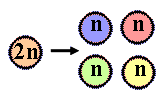 |
The mitotic metaphase can be distinguished from the metaphase I of meiosis as no pairing of homolog chromosomes occurs in mitosis; this is not necessary, even not suitable for the mitotic process (why?). Further, homolog chromosomes separate during metaphase I of meiosis, whereas during mitosis and metaphase II the separating structures are the chromatides. The difference between the separation in mitosis and metaphase II (meiosis) is that halfing of the number of chromosomes has preceeded meiosis II, in contrast to mitosis. Also the meiotic products are genetically diverse with respect to their parent and among each other. This is not the case in mitosis!
Labels: differences


0 Comments:
Post a Comment
Subscribe to Post Comments [Atom]
<< Home